Maz said: “Grant, you should write more dev blogs. And not one every seven weeks when you remember; regular ones.” Well – seven weeks on, here’s a dev blog, because I remembered.
CORRUPTION
I finished Corruption last week. We aren’t doing XP in a normal fashion, because that would be too straightforward, and instead we have three different flavours of advancement that all combine over the course of a game:
– BAPTISM, earned by killing Entities, which gives you temporary access to new abilities and (once per Hollow, when you defeat the Lord) makes one temporary ability permanent
– BONE (and Hearts) which are spent to upgrade the Refuge, allowing a party of Hunters to all gain mechanical improvements and providing continuity between excursions
– CORRUPTION, which is earned from dying and returning to life or otherwise getting your hands metaphysically dirty, and changes you in some sort of physical manner
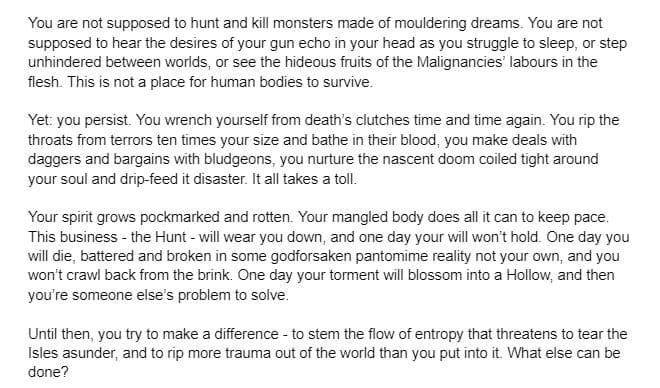
The intro from the Corruption bit, which I’m quite happy with
It works like this: each time you earn 10 Corruption, you get an Echo by rolling on a random table (pictured below). Echoes can be good (boons) or bad (banes) and you can have a maximum of 2 of each active at once. The more Echoes you’ve earned, the more likely you are to a) die permanently next time you kark it and b) get access to the more powerful and dangerous bits of the Corruption section.
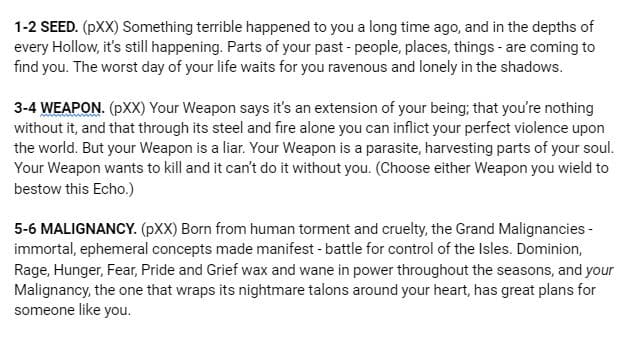
AN EXTENDED ASIDE ABOUT HOW WARHAMMER USED TO BE GOOD, BACK WHEN I WERE A LAD
One of my inspirations for the Corruption table was the old mutation tables from Warhammer. I’ll admit that I didn’t read Slaves to Darkness, the sourcebook which contains the big daddy of randomly-rolled Chaos rules, until I was in my mid-thirties (and doing research for a campaign system for Turnip28 that the creator paid for, but never published) and instead my foray into the world of gribbles was the Citadel Journal issue 21 published in 1997.
The Journal was a paperback zine published by Games Workshop as a place to put all of their spare rules that didn’t warrant inclusion in grown-up publications – they even took fan submissions! – and it was an article on Necromunda Chaos Cults that showed me how exciting a D66 could get:
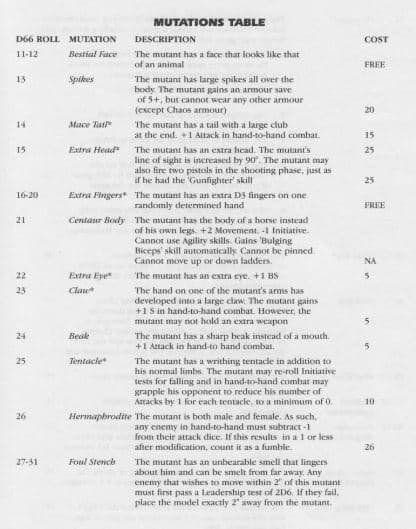
Not sure about result 26 there, but – well – it was a different time, wasn’t it
What really fired me up about the Mutations table – much like, say, long-term injury rules or visiting the trading post for new kit – is that they change miniatures from art pieces which are painted, varnished and finished into something more protean and exciting. If you get a new rifle, you gotta model that rifle on your guy else it doesn’t count, and the same rule applies if you get a third eye or replace your lower half with the back three quarters of a horse. There weren’t official models for a lot of this stuff, and you were encouraged to make it up as you went along by kitbashing pieces together or sculpting your own from putty.
(It’s precisely the sort of thing that GW try to avoid these days, because a) it’s hard to do and b) more often than not, it looks like shit because the average GW hobbyist is a cack-handed fourteen-year-old with the wrong tools. They’ve ditched the improvisational, arts-and-crafts, do-it-yourself ethos of the 80’s and 90’s and replaced it with slick, staggeringly expensive models specifically designed to be so easy to paint that a dog could probably do a half-decent job on a Stormcast Eternal if you taped the brush to its forepaw.)
The deal was that the physical representation of the little guy changed, and not in response to a tactical choice on your end, but to a random table which had good, bad and completely non-mechanical effects in there. I like the shift from “this playing piece is finished” to “this playing piece is a reflection of an evolving fictional entity.” Kingdom Death does something similar with its enormous sprues of hero miniatures and weapon options, but unfortunately makes every single female character an absolute 10/10 dimepiece smokeshow with a dumptruck ass and tits in a different area code, so I don’t feel comfortable displaying them on my shelf in case my mum comes round.
All of this is to say that I wanted to come up with something similar to this with the Corruption table, because Hollows can be a bit ephemeral sometimes (given the looseness of the rules outside combat and how we don’t really give a shit about representing the real world) and I felt that some evocative physical descriptions could really help bring a character and their player closer together, as well as chart a descent into inhumanity.
SEED
Seed is probably the simplest of all the echo types, and probably the hardest to write effectively because it’s so personal. A Seed is the nascent Hollow hiding within every player character – the clenched fist of trauma that gives them access to supernatural powers – and we provide a few ideas for what they could be in character generation. The following excerpt is taken from the Crown section:
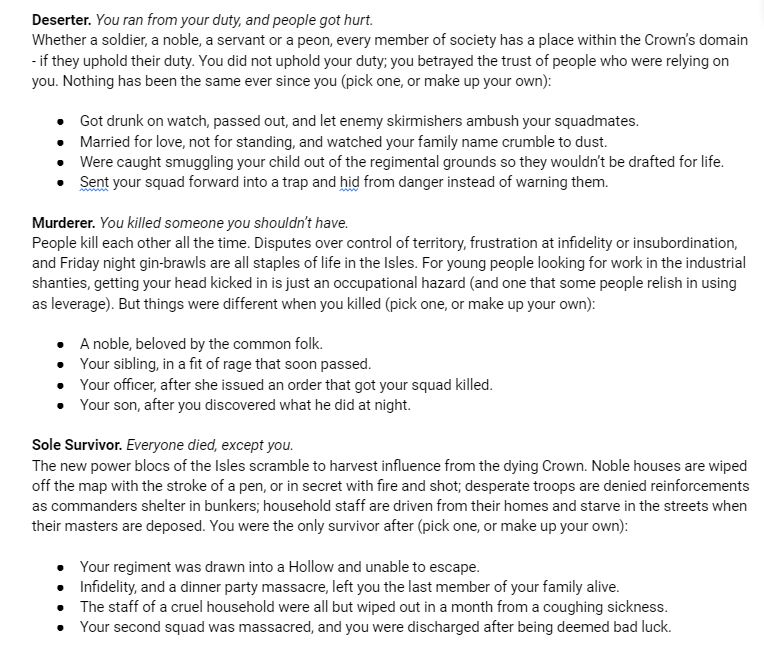
When you earn a Seed Echo, your past comes back to haunt you. It starts cropping up in Hollows as you explore: first as an environmental effect that makes exploration more difficult, then as an invader actively harassing and attacking you, and finally as that same invader subverting and controlling the native Entities to make your life harder. We were keen to find a way to let players and GMs discuss each character’s tragic backstory, but we were mindful to keep our focus on the Hollow itself.
I really like the way that your trauma can follow you around, even into someone else’s personal hell, and impact the lives of those around you. There’s no positive outcome to rolling a Seed Echo, and they only get worse over time.
(Which is to say: you’re tormenting yourself, and perpetuating a cycle of self-violence. The Seed is a hell of your own making from which you cannot escape. I have spent hours – days – ruminating on the past, wishing I could make it different or experience it again or that it never occurred, and it never helped me once. I broke the truth apart through repeated rememberings and let the shards of it run through my fingers.)
WEAPon
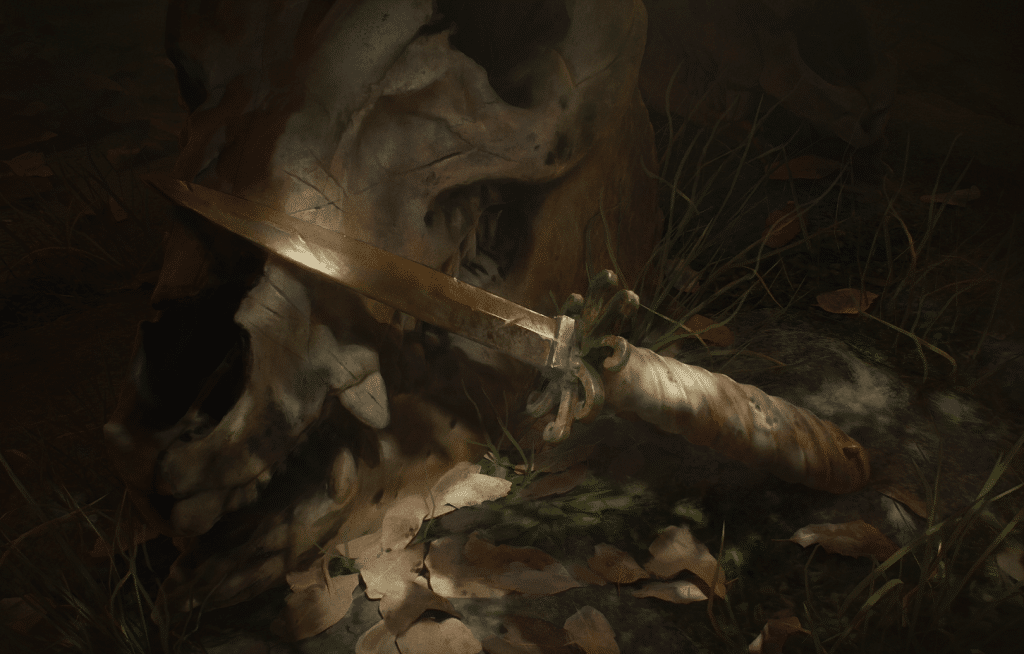
Weapon art (and header image!) by the talented Sam Lamont
Weapon Echoes were a bit easier, because we’ve already got lots of rules in the book about Weapons already. Your Weapon sends an Effigy into the Hollow – something between an avatar and two tin cans with string tied between them – to make contact and bestow gifts upon you.
The Weapon Echoes are, on the whole, the best type to roll from a mechanical standpoint. There’s little in the way of negative mechanical modifiers, and a whole lot of damage buffs – and seeing as this is a game about kicking the snot out of big monsters, you want damage buffs.
(With this, we wanted to offer the Weapons up as a good idea. Partially because within the cosmology of Hollows the Weapons each form a petty godling with a single worshipper, and partially to illustrate the perpetual draw towards violence, anger and unkindness that I’ve experienced myself through my time being a man – especially a younger one, full of piss and vinegar. Before I was sad all the time, I was angry all the time, because anger felt good. Anger felt like I was doing something.)
MALIGNANCY
Malignancies are what we have in place of gods in Hollows. (We do also have gods, but they’re all officially dead, their followers know this, and it’s a whole rebirth thing.) There are six of them – Hunger, Fear, Dominion, Pride, Fury and Grief – and they’re all a toxic exaggeration and perversion of a fundamentally human emotion.
One of the Malignancies picks you (which is to say that the player chooses which one they want, in discussion with the GM) and forms a bond. Following that, each Malignancy comes with four further gifts:
MARKS, which knock a point off a stat
BURDENS, which forbid you from performing a particular action on your turn
CONDUITS, which trigger you a special effect on death
BLESSINGS, which add a point to a stat
My favourite one of these is Burdens, because special abilities and stat increases are all well and good, but telling a player that they can no longer enter the Front section of the tactical grid during their turn can really shake things up. Some of the Burdens won’t matter at all – a character without a firearm who’s banned from reloading doesn’t really change their behaviour at all – but, I hope, some of them will necessitate a different playstyle. We were really keen to allow other players the opportunity to let you overcome Burdens by granting actions on their turn; really, the only thing that can help you overcome toxicity and obsession is making friends, and giving and accepting help.
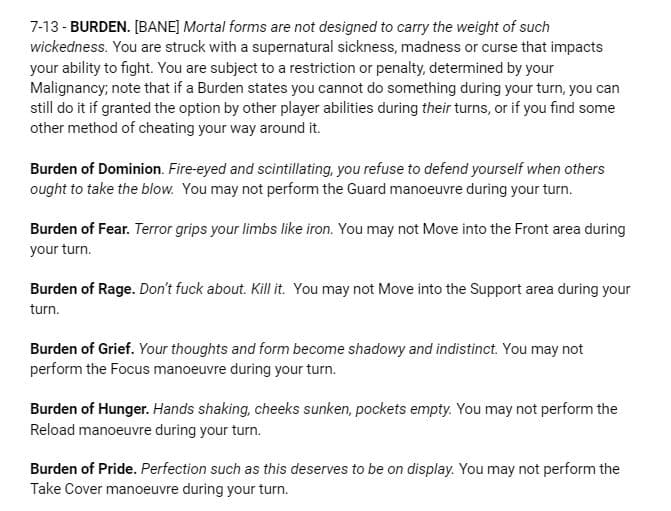
The more Echoes you’ve earned, the more likely you are to get Conduits and Blessings and the less likely you are to get Marks and Burdens – the Malignancy is looking after you.
(I wanted to illustrate one of the most dangerous things about toxic behaviour: it works. It’s easier than the alternative. It gets results and there’s rarely any immediate reprisals for doing it. And other toxic people look out for you, promote you and empower you, because that works for them. It’s a pyramid scheme of abuse. It’s exhausting.)
That’s all for now. As we’ve drafted a new producer onto the project – Chant Evans, formerly of Cubicle 7, now herding cats for us full-time – I’ve had a lot more direction and it’s been easier to focus my attention on one part of the document, so hopefully you can look forward to more blogs. Or maybe just a finished game before 2025. That’s probably something sensible to aspire to.
Stay vicious,
- Grant
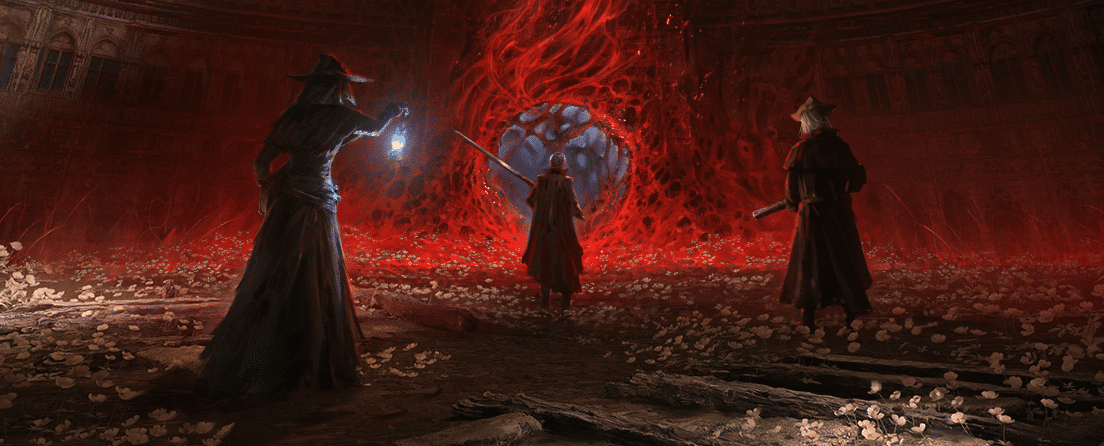
Comments
There are no comments yet.